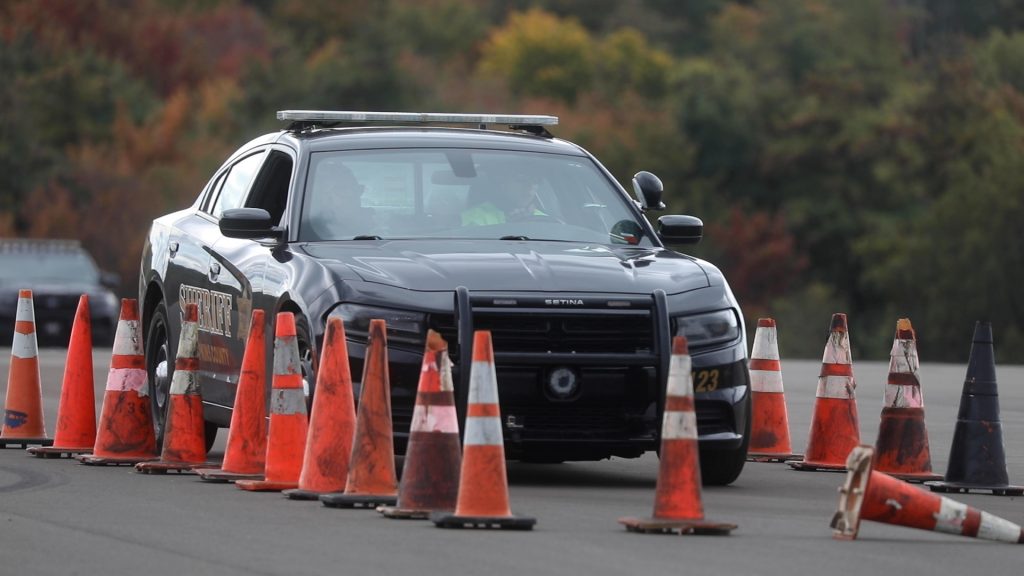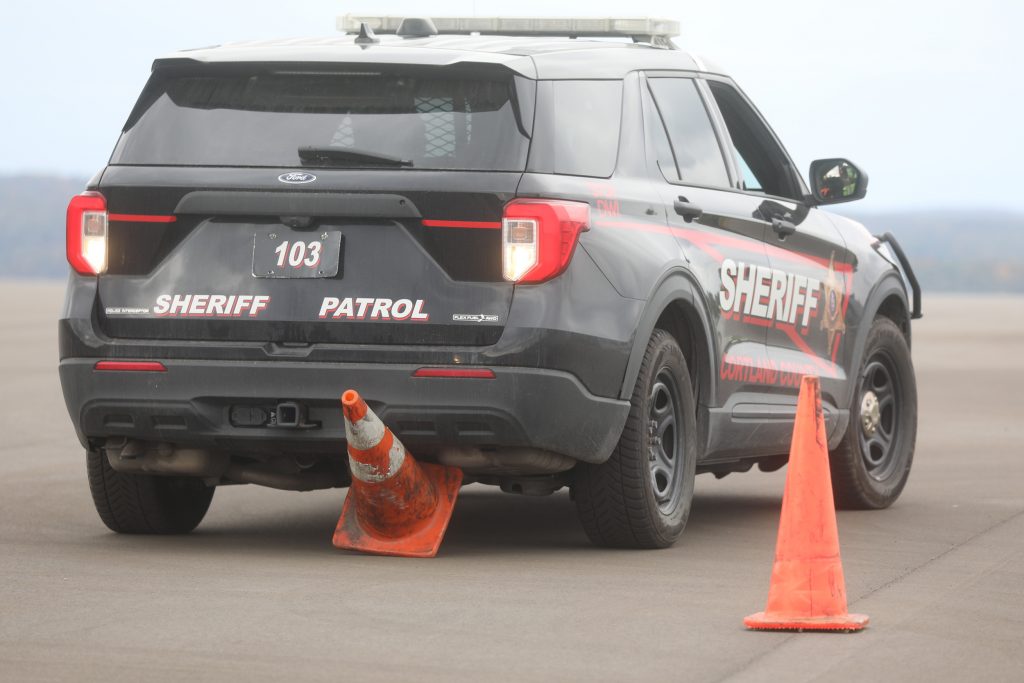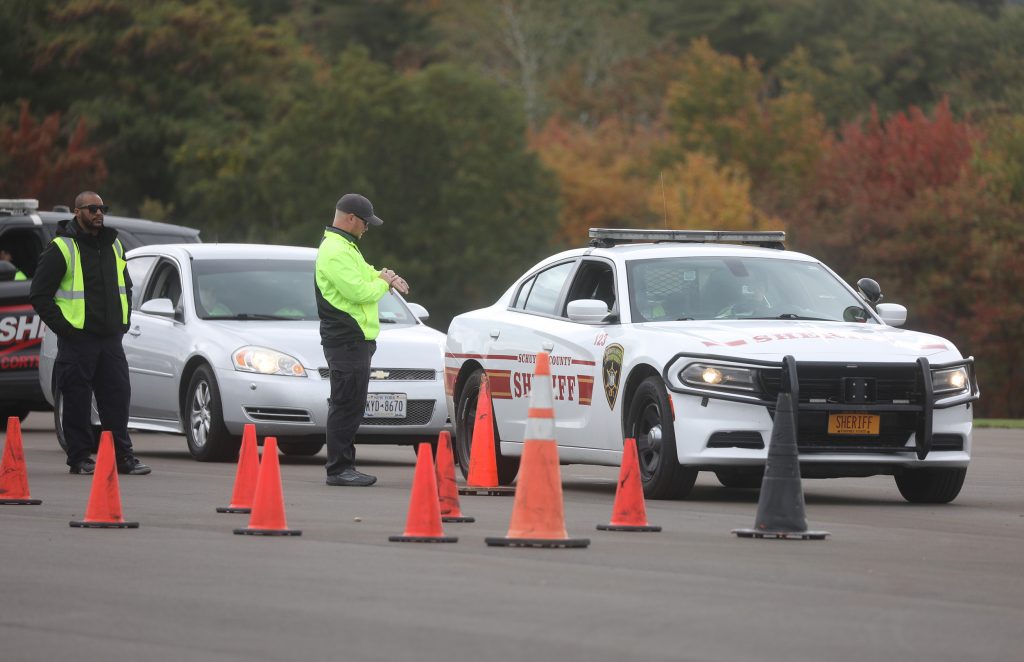Do NY police officers get enough training to curb vehicle crashes?
Do NY police officers get enough training to curb vehicle crashes?
Emergency driving training makes up just 3% of an officer’s training time in NY, raising questions about whether that’s enough to curb crashes.
A joint investigation between the S.I. Newhouse School of Public Communications, Central Current and USA TODAY Network-New York.

Keeping calm at emergency speeds
The concern for Hughson and other instructors, however, is that calmness and confidence typically come from getting plenty of training and experience.
The proficiency advantage was clear with Agnes Olson, a 23-year-old SUNY Cortland police officer who has a commercial driver’s license and took prior emergency driver training as a volunteer firefighter.
Just moments before her turn to drive, Olson told a reporter: “I think it’s going to be challenging.”
Then, she walked onto the course and expertly weaved her cruiser between the cones on a few runs — the first one a bit jerky with near misses of cones before she smoothed out later attempts. Upon return to the sidelines, she delivered the top time: 1 minute, 44 seconds.
Do simulators make a difference in police training?
The USA TODAY Network-New York surveyed driving training programs at dozens of police academies across New York, and found some programs ranged from 28 hours to 42 hours.
Of the 12 responses to the Network’s inquiry, just one academy in Orange County had a driving simulator. The academy recently bought the roughly $100,000 device with a grant and is using it mostly to offer post-academy driver training for local officers.
But authorities in other counties, including Westchester, Monroe, Broome, and Erie, offered various reasons for lacking a simulator.
Some academies stopped offering the training when aging simulators broke. Others never had the device. Several officials described challenges securing funds for simulators.
Academies in the Capital Region and Central New York did not respond to emails and calls about the matter.

At the same time, insurance companies found driving simulators are well worth the investment. Training programs in Georgia that coupled simulators with on-course driving reduced officer crashes by 10%, insurers reported in that state.
Put differently, the technology provided at least a 12-to-1 return on investment by curbing vehicle repairs and insurance liability costs linked to crashes, according to the insurance study headed by Robert Hoyt, a risk management professor at the University of Georgia.
“Officers are being asked to operate vehicles at accelerated speeds and high-stress situations,” Hoyt said. But on-course and classroom training alone, he added, cannot prepare them for all the driving hazards.
“Much like they learned in the airline industry years ago; for the stuff that really can be devastating, you can’t really simulate for it without the digital training,” Hoyt said.
Guns versus cars
The gold safety standard in law enforcement are the departments that require annual or biennial on-course driver training for all officers. Some agencies also require supervisors ride along with rookies for months, or following all crashes, before letting them on the road alone.
But many departments, Hughson, said, fall short of these best practices.
“I would like to do more in-service driver training,” he added, “but there’s a training budget that is tough to change.”
Syracuse police, for example, had a training budget that covered some remedial driver safety course work from 2013 to 2020. The overall training budget, including many non-driving skills, accounted for 1% of the department’s roughly $45 million budget.
Then in 2021, the department boosted driver training to include annual emergency vehicle operator course training, following years of officer crashes that led to costly legal settlements, vehicle repairs and myriad injuries.
The stark contrast in training mandates for firearms and driving, in general, further underscored the priorities for local and state standards.
“We don’t shoot our guns all the time, but we have to get recertified,” Hughson said. “It should be the same for driving because it is serious, too.”
That seriousness also recently struck home for Hughson, who tried to relay the many driving risks to his newly licensed teenager.
Recalling the talk with his daughter, he said: “The car you’re driving is a missile going down the street, and you hope the person in the missile heading in the other direction is driving as safe as you.”
How did Las Vegas PD fix deadly driving problem?
It took three officers dying in crashes within a year for the Las Vegas city police department to rethink its driving policies in 2010.
But, in some ways, the third case forced the positive change: A rookie officer died in a crash while driving nearly 100 miles per hour in a 25-mph zone. At the time, he was off-duty and heading home, talking with his girlfriend on a cellphone, Hope Tiesman, a federal driving safety expert, recalled recently.
“For Vegas, its cops were going fast because they could and really turning it into a cultural thing,” Tiesman said, “motor vehicle safety wasn’t part of who they were.”
Then Vegas police leadership made driving safely a priority. It in part capped officers’ emergency response speed at 20 mph over the limit. It required annual driver training for new officers’ first three years and biennial after that. Safe driving stickers, posters and videos became ubiquitous.
Crashes and injuries among Vegas police plummeted 14% and 31%, respectively. Federal officials revealed those results in a 2019 report, launching a campaign to have other departments follow the model, said Tiesman, a research epidemiologist at the National Institute for Occupational Safety and Health.
But adoption has been slow, she added, in part due to the pandemic and the 2020 social justice movement that prioritized addressing other types of police misconduct over driving safety.
Some police agencies in New York, including in Westchester and Putnam counties, use a training program called Below 100, which aims to reduce line-of-duty deaths nationally to fewer than 100 per year, a level not seen since 1943, Kieran O’Leary, Westchester County Police spokesman, said in a statement. Some of that in-service training includes driving skills, he added.
Meanwhile, police-involved crashes nationally injured tens of thousands of civilians, while officer deaths linked to motor vehicles mounted.
The most recent data showing officer line-of-duty deaths between 2012-2022, excluding COVID-19 deaths, according to the National Law Enforcement Officers Memorial Fund, included:
· 1,811 total deaths
· 326 deaths due to vehicle crashes (18% of total)
· 166 deaths due to being struck by a vehicle (9% of total)
The rising cost of police crashes also gained attention when authorities this year revealed New York City settled nearly $247 million in New York Police Department crash claims from 2012 to 2021.
That is nearly 38% of the total claims involving the city’s fleet of thousands of vehicles. It stemmed, in part, from the police transition to using more SUVs, which caused more serious and deadly crashes while striking more bicyclists and pedestrians, the audit found.
But despite mounting evidence to the contrary, some police officers still view vehicle crashes as an unavoidable part of a job that requires lots of driving, with the added risks of occasional emergency responses.
The truth, Hughson said, is that crashes keep piling up due to flawed approaches to officer discipline and driving education.
“It really comes down to accountability and that retraining,” he said.
What’s your story?
Have you been hit by a police vehicle as a pedestrian, bicyclist or driver? Have you faced damage to your property in the aftermath of a police vehicle crash?
We want to hear your story and your questions that remain after the experience. Fill out our online form, or scan the QR code if you’re reading this story in print.
This investigation will continue into the early summer. You may be contacted by our reporters for further details about your experience as part of our continuing coverage of police vehicle crashes.
More from Driving Force
The heavy toll of NY police crashes: Syracuse police officers crashed their vehicles hundreds of times between 2013 and 2022, with some wrecks leaving civilians with lasting injuries.
Troy Police Officer Justin Byrnes rammed his cruiser into Sabeeh Alalkawi’s vehicle at 88 miles per hour in the early hours of Feb. 22, 2023, killing Alalkawi, a father of twin sons who was heading back to his workplace.
About the project
This story is part of Driving Force, a police accountability project meant to expose and document the prevalence of police vehicle accidents in New York.
This joint investigation between USA TODAY Network-New York and Syracuse University’s S.I. Newhouse School of Public Communications was supported with funding from the Data-Driven Reporting Project. That project is funded by the Google News Initiative in partnership with Northwestern University-Medill.
This reporting was completed in partnership with Central Current, a Syracuse-based nonprofit newsroom.
Reporters, visual journalists, editors, designers and project partners include Maria Birnell, Evan Butow, Kayla Canne, Daniel DeLoach, Anna Ginelli, Jon Glass, Seth Harrison, Nausheen Husain, Hayden Kim, Annabella Leuzze, Chris Libonati, Beryl Lipton, Tina MacIntyre-Yee, Peter Pietrangelo, William Ramsey, David Robinson, Kyle Slagle, Eden Stratton, Sarah Taddeo and Jodi Upton and Marili Vaca.

